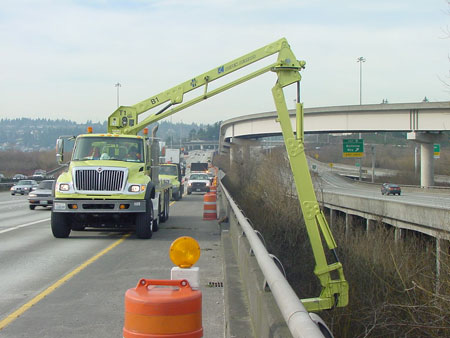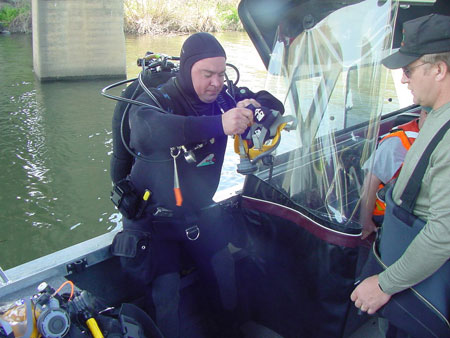U.S. Department of Transportation
Federal Highway Administration
1200 New Jersey Avenue, SE
Washington, DC 20590
202-366-4000
Focus
| Accelerating Infrastructure Innovations |
Publication Number: FHWA-HRT-13-009
Date: December 2012
Printable Version (.pdf, 0.3 mb)

When conducting inspections, some bridge elements can only be reached using specialized equipment.
In 2011 the Federal Highway Administration (FHWA) introduced a new bridge safety initiative that uses systematic, data-driven, and risk-based reviews and analysis to improve oversight of how States perform their bridge inspections and manage overall bridge safety. During the first year, these reviews found that States have robust inspection programs overall, while identifying specific areas for improvement to achieve consistent compliance with the National Bridge Inspection Standards (NBIS).
The initiative replaced FHWA's prior National Bridge Inspection Program oversight practices and the annual NBIS compliance reviews conducted by FHWA State division offices. FHWA now assesses bridges using defined criteria for 23 key metrics, each of which can be linked directly to requirements in the NBIS. These key metrics include inspection file records; determination of bridge load limits; qualifications of inspection personnel; procedures for underwater, fracture-critical, and complex bridge inspections; quality bridge data; and inspection frequency.
Instead of determining an overall level of compliance for a State, FHWA makes an individual compliance determination (satisfactory, actively improving, or unsatisfactory) for each of the 23 metrics. The assessment process is based on objective data, statistical sampling of the data and inspection records, site reviews of bridges in the field, and defined criteria for compliance with each metric.
"By evaluating the inspection program in this way, FHWA and a State can more readily identify areas of good practice, those needing improvement, and how this information can be used to take corrective actions," said Barry Brecto of FHWA.
The 2011 reviews also established a baseline for future years' reviews.
Seventy-one percent of the metrics for the 50 States, District of Columbia, and Puerto Rico were assessed at the satisfactory performance level, while 29 percent were assessed as actively improving. Those listed as actively improving have tailored plans in place to accomplish the needed corrective actions to meet the requirements of the inspection standards. Less than 1 percent of the metrics were assessed at an unsatisfactory level, representing areas that need immediate attention and improvement.
Nationally, the most challenging program area is compliance with the inspection intervals identified in the NBIS, as States must balance large structure inventories, difficulties in resource allocation, and the vulnerability of bridge inspection operations to the weather and other environmental conditions. FHWA has worked with the American Association of State Highway and Transportation Officials (AASHTO) to adjust the metric assessment thresholds and issue guidance on handling special circumstances that can affect inspection schedules. Other areas that require increased attention are identifying scour critical bridges, implementing plans of actions for these structures, and establishing documented load ratings for all bridges.
A task force formed by FHWA and AASHTO identified several recommended improvements to the bridge inspection oversight process. Many of these improvements are being implemented as part of the 2013 assessment cycle. For example, improvements have been made in the way bridge inspection quality is assessed, bridge data quality is measured, and how the procedures used for underwater bridge inspections consider and account for the risk associated with these elements. Additional changes were made to better communicate the assessment results to a broad audience and mitigate risk through clarification of inspection procedures, rather than just tighter inspection frequency tolerances.
"The new oversight process has enabled States and FHWA to more strategically understand and articulate the importance, status, and needs of the national bridge inspection program," said Tom Everett of FHWA. "The improvements being made will enable States to more efficiently manage their bridges to keep them safe for the traveling public and maximize their service life. States will also be positioned to better take advantage of future advancements in data collection, bridge management, and technology innovation."
For more information about the bridge safety initiative, contact Tom Everett at FHWA, 202-366-4675 (email: thomas.everett@dot.gov).

An underwater diver gets ready to inspect a bridge.